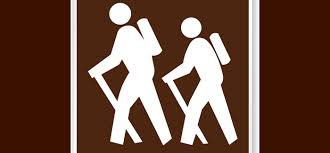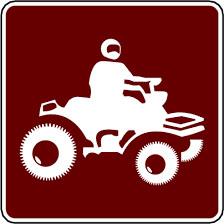SHARING OUR TRAILS
- A GUIDE TO TRAIL SAFETY AND ENJOYMENT
Responsible trail enthusiasts, have much in common, they have an appreciation for our public lands and want to enjoy what our public lands have to offer.
Smart trail use includes adherence to some basis safety practices. Trails are shared recreation amenities and are accessed by a variety of users at the same time. Please be
courteous to all users, and remember that pedestrians have the right-of-way. All trail users should stay to the right on the trail.
Trails are open to and shared by equestrians, Off-Highway-Vehicle (OHV) riders, bicycle riders, runners and hikers. Trail sharing can and does work when people respect each other and work cooperatively to keep each other safe.
While it is important for people to respect each other on the trail, it is important to remember that equestrians are dealing not only with other trail enthusiasts' personalities, they also are working with horses whose temperaments are as individual as our own. Horses' natural instincts can influence their behaviors and affect the way they react to circumstances encountered on the trail.
When young or inexperienced horses encounter new conditions on the trail like OHVs,
bicycles, runners and hikers, and even certain scents, the flight response can end
with disastrous results for the horse or rider.
When equestrians on well-trained horses and other responsible trail enthusiasts meet
each other on the trail the encounters can be enjoyable social exchanges if the
groups understand how to work together to keep the encounters safe.
-
Respect all trail restrictions and use only trails open to your mode of transportation.
-
Be considerate of others on the road or trail.
-
When traveling on shared use trails, continually watch for other types of recreationists.
-
Keep speeds low around other recreationists.
-
Keep noise and dust down.
-
Keep your ears open - Listening to headphones or ear buds can make it difficult to hear and communicate with other recreationists. In some areas it is illegal to operate vehicles or bikes with both ears covered.
Yielding
-
Motorized vehicles yield to mountain bikes, runners, hikers, and horses.
-
Mountain bikes yield to runners, hikers and horses.
-
Runners and hikers yield to horses.
Guidelines for equestrians on shared trails
-
Be sure you can control your horse and it has been exposed to other trail recreational uses before riding on shared use trails.
-
Cooperate with local OHV and bicycle riders to expose your horse to vehicles in a gradual manner in a safe environment.
-
Be alert and aware of the presence of other trail enthusiasts. If possible, pull to the side of the trail when you hear oncoming OHVs or bicycles.
-
At trailheads or staging areas, park vehicles and secure stock in a manner that provides a safe distance between the horses and passing traffic.
-
Be prepared to let other trail enthusiasts know what needs to be done to keep you, the horse, and other trail enthusiasts safe when you meet on the trail.
-
Less experienced horses and riders should ride behind more "trail-wise" horses and riders.
Guidelines for bicyclists when encountering horses on the trail
-
Pull to the side of the trail far enough for horses to pass safely as soon as you see horses.
-
Pull to the downhill side of the trail if possible since horses tend to perceive unknown threats on the uphill side as predators.
-
Speak to the oncoming rider and horse in a friendly, relaxed tone. Remove your helmet if it conceals part of your face. The horse will be more likely to recognize you as a human.
-
Horsemen may pull to the side of the trail a safe distance if they hear a bicycle approaching but this does not necessarily mean it is safe for you to ride by. Stop and wait for instructions from the horseman.
-
Be alert - be aware and on guard for oncoming traffic.
Guidelines for other non-motorized recreationists when encountering horses on the trail
-
Hikers and trail runners should always stop and step to the side of the trail when they meet horses on the trail.
-
Step to the down-hill side of the trail.
-
Speak to the rider and horse in a friendly, relaxed tone.
Interested in safe biking?
Whether biking alone, or with your fellow biking friends, it is always important to remember the basics that will keep your cycling both fun and safe. The follow points might come across as really obvious, however, it is normally by ignoring or forgetting one of these simple facts that a great day's cycling turns into a bit of a nightmare. Here are our suggestions for you.
-
Put that helmet on your head
-
All the safety gear
-
Know your fitness
-
Know where you are and where you're going
-
Basic first aid
-
A safe bike
Finally On the Trail
- Never hit the trail without a buddy, and never leave the buddy behind.
- Wear a certified helmet that fits snugly and always buckle the chin strap.
- Always carry a fully charged cell phone, flashlight and water. Take advantage of the technology available to you!
- Carry an ID and put identification information inside your helmet. Be sure to include your name, address, phone number and emergency contacts.

Remember

Use Your Manners!

Be friendly to other people you encounter on
the trail.

AND BE SAFE.
See you in the OUTDOORS....









